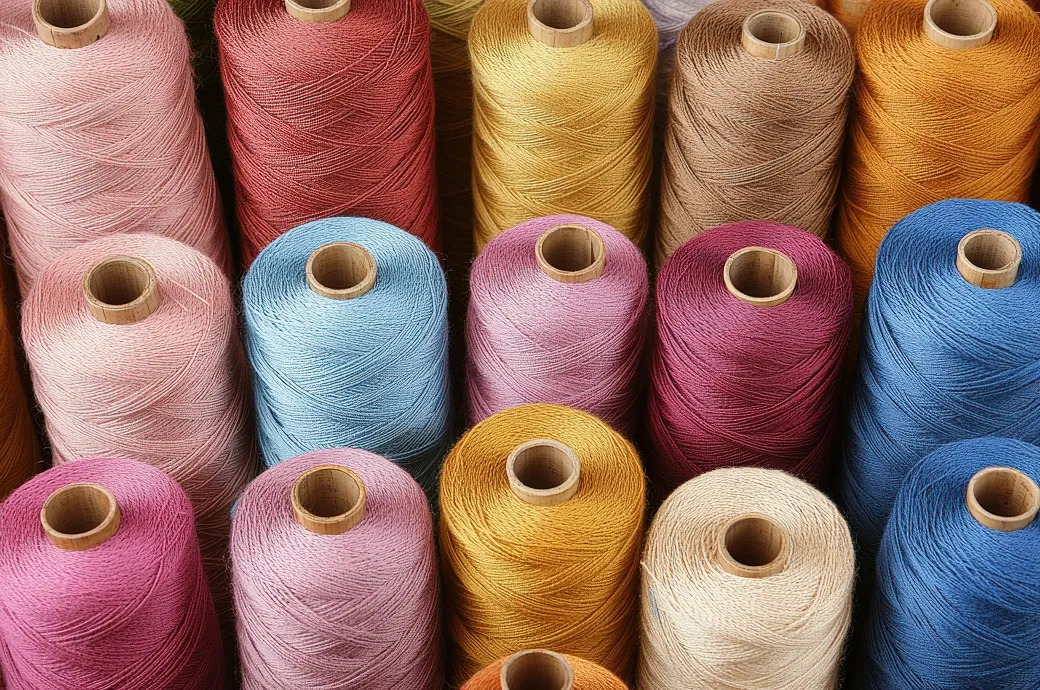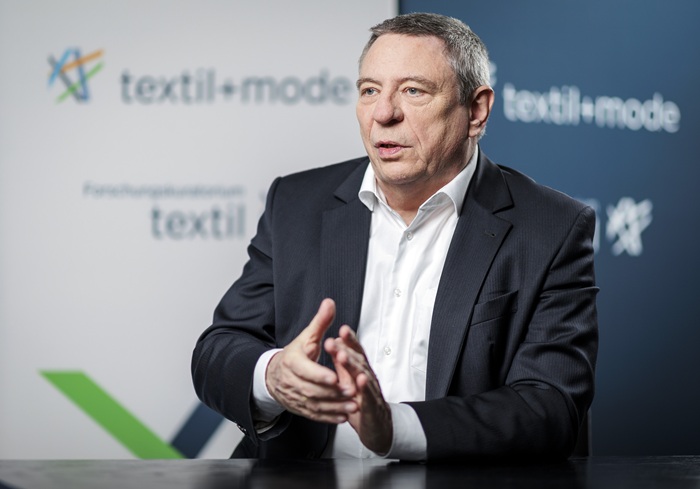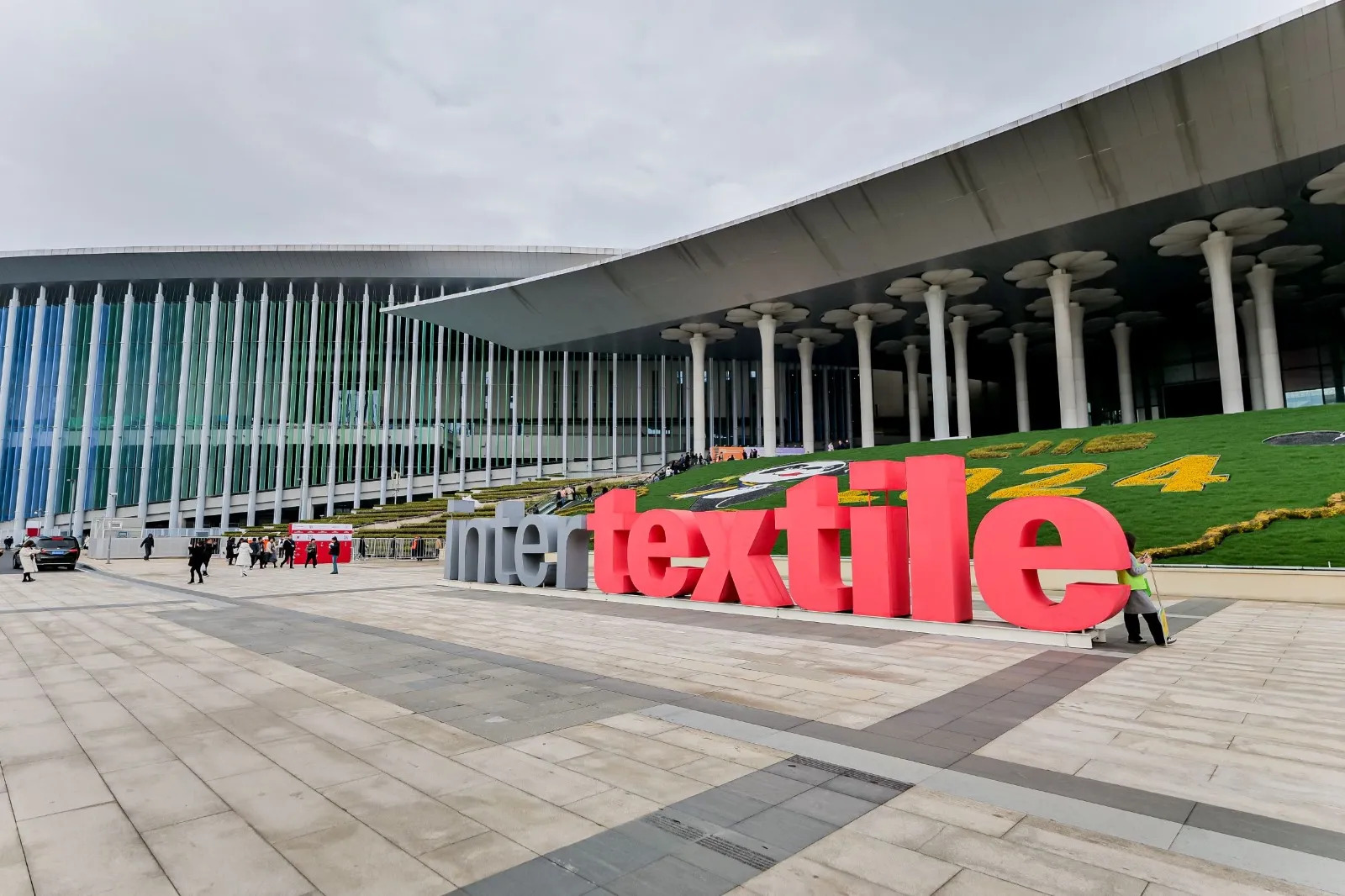FW
The third edition of Garments Machinery Manufacturers & Suppliers Association (GMMSA) expo is now on in Ludhiana, the knitwear hub of India. The event is focussed on knitting (circular and flat) technology used in garment manufacturing. On day one, key technology solutions providers displayed latest innovations. Technology giants such as Stoll, IIGM, HCA, Magnum Resources, Ramsons, INA Systems, Aeon Commercial India, Grafica, Epson and Narinder International are present at the four-day exhibition.
Big garment exporters including MiniKing Knitwears and a significant number of mid-level organisations across India have already visited the show. Chandra Bhan Kataria, Founder & Director of Noida-based high-end knitted garment manufacturer Katbro Corporation says, “The current market situation is stable and my business is on the right track, thereby, I am planning to add some knitting machines to the existing knitting division and that’s why I am here at the show.”
Sanjay Kumar, Merchandiser, Pruthi International hopes to expand with some good-quality knitting technology and GMMSA is the best platform for that. Technology solution providers are expecting a significantly business at the fair as Ludhiana is continuously moving towards automation. Day 1 also saw the launch of cylinder bed top and bottom cover stitch machine by HCA. The company has presented this technology for the first time in this market, seeing its potential. The tech giant also put on show its ‘Kansai Special’.
ITMA 2019 will feature a number of industry-leading knowledge-sharing events to facilitate sharing and collaboration among global textile and garment industry members. Sustainable innovation, Industry 4.0 and automation will be key agendas during the show.
As per CEMATEX, owner of ITMA 2019, the cluster of accompanying events will highlight key industry challenges and cutting-edge solutions that will support industry members' drive for sustainability and competitiveness.
Fritz Mayer, President of CEMATEX, elaborates, "ITMA has evolved beyond its original aim of merely providing a buy-and-sell platform for textile machinery manufacturers. It is now a meaningful platform for all industry stakeholders to share new breakthroughs, brainstorm solutions and explore collaboration.”
Two events that have been successfully organised in conjunction include the Textile Colourant and Chemical Leaders Forum and the Nonwovens Forum. The 3rd Textile Colourant and Chemical Leaders Forum @ ITMA 2019 will focus on the theme: The Circular Economy and Resource Sustainability Strategy.
Andrew Filarowski, Chairman of the forum's organising committee and technical director of the Society of Dyers and Colourists says discussions will centre on the circular economy and resource sustainability strategy and how textile chemicals and innovative and cleaner technologies can support it under the influence of Industry 4.0 emerging strategic concept. The forum will be held on June 23, 2019.
ITMA will jointly organise the Nonwovens Forum @ ITMA 2019 with the International Association for the Nonwovens and Related Industries (EDANA). The one-day event on June 21 will feature discussions on the latest innovations in nonwovens based on the theme: Nonwovens manufacturing processes for the 21st century: more flexible, efficient, sustainable.
Pierre Wiertz, General Manager, EDANA, says they are are always exploring ways to help the industry to create a strong foundation for sustainable growth of the nonwovens and related industries through education and dialogue. Hence, we look forward to working with ITMA on the Nonwovens Forum.
For the widest selection of sourcing options in one place, the best place to visit is the Intertextile Shanghai Apparel Fabrics expo to be held from March 14 to16. Country pavilions by Japan, Korea, Pakistan and Taiwan will showcase their wares as well as individual exhibitors from Hong Kong, India, Indonesia and Vietnam, including 2,800 + Chinese exhibitors. The fair is the largest gathering of Asian suppliers under one roof for the spring/ summer season.
To ensure convenience for buyers, international exhibitors are grouped by country or region, while Chinese exhibitors are located in product halls including fabrics for casualwear, functional wear/sportswear, ladies wear, lingerie and swimwear, shirting and suiting and accessories and denim. Around 3,300 exhibitors will showcase their apparel fabrics and accessories at the fair, with the Salon Europe zone hosting premium suppliers from Europe – including pavilions and zones from France, Germany, Italy and Turkey – while the International Hall also houses other overseas exhibitors from Argentina, Australia, Peru and the US amongst other countries.
Organised by the Japan Fashion Week Organization (JFW), the Japanese Pavilion will house 22 exhibitors and also feature a Japan Trend Corner. “The now mature Chinese market tends to seek out very different types of products and purchase in smaller batches, which is a world away from the mass-production focus of the past,” JFW noted. Included in this edition’s Japan Pavilion are three companies from the Nishiwaki region, which is famous for its ‘Banshu-Ori’, or Banshu weave. Banshu-Ori is a yarn-dyed fabric, woven into various patterns such as checks and stripes, with yarns that are dyed before being woven by weaving machines.
The Taiwan Pavilion, with over 40 participating companies, is a guaranteed source of innovation at the fair, with a number of exhibitors also offering eco-friendly options. Some of the highlights include: Keen Ching Industrial: they will have a number of their patented KCC-branded zippers at the fair including a durable double-coil zipper, an invisible zipper with a movable retainer box, a track type water-repellent zipper, a curved metal zipper and more.
As per World Trade Organisation textile industry is a major driving force for Indonesia’s national economy. In recent years, the government has supported widespread modernisation program of existing technology, permitting increased exports in the garment industry, and making Indonesia the 8th largest exporter in this sector worldwide.
Italy’s textile machinery sector has also benefitted from this increased demand in cutting edge technology from textile manufacturers. Alessandro Zucchi, President of ACIMIT says, over the course of few years, Indonesia has become one of the primary markets in Asia for their machinery manufacturers. With roughly €25 million worth of Italian machinery sold over the first nine months of 2017, (recording) a 19 per cent increase over the same period of 2016.
“Bearing witness to the interest in Italian technology on the part of the Indonesian market, an Italian exhibition area will be present at the upcoming edition of Indo Intertex, to be held in Djakarta from April 4 to 7,” says Zucchi.
A total of 13 Italian machinery manufacturers will be on hand in the common exhibition area set up by the Italian Trade Agency and ACIMIT, the Association of Italian Textile Machinery Manufacturers. Among the companies exhibiting in the Italian area are the following ACIMIT associated members: Bonino, Busi, Caipo, Cognetex, Lgl, Mcs, Ms Printing Solutions, Red Carpet, Santex Rimar Group, Sei Laser, Sicam and Ugolini.
Italy’s participation at Indo Intertex is part of an intensive program of trade initiatives aimed at promoting the Italian textile machinery industry in Indonesia. In addition to participating in previous editions of Indo Intertex, recent activities carried out in partnership with the Italian Trade Agency include various technology symposia at major Indonesian districts and a variety of incoming missions in Italy by Indonesia’s textile operators.
California may have a law requiring clothing made from fabric that is more than 50 per cent polyester to bear a label warning that the garment sheds plastic microfibers when machine washed. If the bill passes, the sale or offering for sale of clothing without this label would be prohibited as of January 1, 2020. Hats and shoes would be exempt.
According to the bill, garments made from synthetic fibers such as polyester can shed up to 1,900 microfibers per wash. Since these fibers are small enough to get past filters, they end up in waterways and the ocean. A study of fish sold at California fish markets found 25 percent of fish and a third of shellfish contained plastic debris, with the majority of that plastic debris being microfibers.
Microplastics have the potential to poison the food chain, as these tiny beads of plastic have been found in the stomachs of marine life, as well as the supply of drinking water. It’s estimated that the world’s oceans will contain more plastic than fish by 2050.
The California bill is meant to be in line with other efforts in the state aimed at reducing water pollution, including a ban on personal care products containing plastic microbeads.
Planet Textiles will be held in Canada on May 22. This event on textile sustainability will feature sessions on finance, deforestation and water as well as a key focus on the growing issue of textile microfiber pollution.
Top industry leaders and environmental experts will speak on issues of scaling up sustainable innovation, the problems of textile microfiber pollution, financing innovation, deforestation and raw material selection, and traceability and harmonisation of textile chemistry in relation to water.
Scaling up innovation will be a major focus throughout this year’s Planet Textiles but the issue of microfiber pollution in aquatic environments, deforestation and the man-made cellulosic industry, chemical management in relation to wastewater and effluents and plenary sessions from leading retailers and brands will also feature.
A special new innovation at this year’s event will be a media area where selected filmed interviews and podcasts will take place, which will then be available to delegates and the rest of the industry after the event closes. Video interviews will explore a range of new technologies, innovations and strategies from both invited attendees and speakers based around the event themes.
Sympatex, which develops, manufactures and sells membranes, laminates, functional textiles, finished products for a range of apparel will outline how the company has implemented sustainability into its product range.
"Growing consumer awareness on sustainable clothing has been pushing eco canvas for leading companies. In order to abide by the laws of nature, H&M’s Conscious Collection is one such catalogue that uses organic and recycled materials to produce fairly-priced clothes that are mindful of environmental obligations and human rights standards, while helping invest in the local communities in which they are produced."
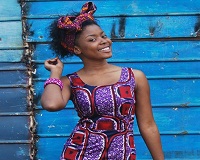
Growing consumer awareness on sustainable clothing has been pushing eco canvas for leading companies. In order to abide by the laws of nature, H&M’s Conscious Collection is one such catalogue that uses organic and recycled materials to produce fairly-priced clothes that are mindful of environmental obligations and human rights standards, while helping invest in the local communities in which they are produced.
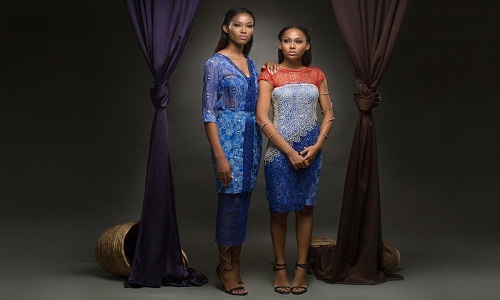
The apparel industry has developed higher labour and environmental standards with an aim to encourage consumers to alter their methods of care for clothing, by offering recycling options and the possibility of investing in higher-priced garments made from eco-friendly fabrics. The Ethical Fashion Initiative (EFI) tends to alter by stressing on the work of fashion artisans in developing countries. Founded in 2009 by Simon Cipriani as a flagship program of the International Trade Center, the Ethical Fashion Initiative connects local designers working in the fashion industry in the developing world with international fashion industry.
Working primarily in Burkina Faso, Cambodia, Ghana, the West Bank and Haiti, the EFI gives artisans the opportunity to expand their market reach to the global fashion industry honchos, such as Stella McCartney and Vivienne Westwood. Empowering nearly 7,000 artisans, the success of the initiative culminated in 2013 with the participation of micro-producers and their designs at the Rome Fashion Week. Commenting on the initiative, Hans-Peter Egler, Head of Trade Promotion at Switzerland’s State Secretariat for Economic Affairs (SECO), says ethical fashion is not just about a one-way transfer of products from developing countries to the global fashion industry, it’s about a two-way exchange with the North and South being able to cooperate from each other. This is a new way of cooperation. Groups like EFI are taking note of Africa’s nascent industry in part to educate African artisans on their labour rights, and alternatively to raise awareness of on how to buy and sell fashion goods in a more responsible manner.
Starting a new chapter
EFI initiative is majorly targeting wealthy consumers who are able to purchase high fashion items. Indeed African brands aren’t competing against big retailers, but they want to influence the change in consumers’ buying pattern from fast fashion to ethical fashion. While large retailers such as Zara and H&M would not be impacted majorly but they are the ones who appeal to the masses. African brands aim to change the face of fashion to one where coloured designers can succeed, where garment workers are safe and finally where Africa’s textile heritage shines through. According to the brand officials, momentary outrage against sweatshop conditions isn’t enough, we must become aware that our purchases allow for their existence, but in turn, can also prevent their survival and leave space for a more ethical fashion industry to grow.
China’s Belt and Road Initiative may help Nepal realize its dream of development and economic prosperity. Nepal, a land-locked and least developed country, needs the cooperation of neighbors, especially China, to upgrade its status to a developing country. Introduced by China in 2013, the Belt and Road Initiative aims to build a trade and infrastructure network connecting Asia with Europe and Africa along the ancient trade routes of the Silk Road. The Belt and Road Initiative is expected to bring opportunities in multiple fields including trade, connectivity, physical infrastructure development, tourism and investment.
China and Nepal are interested in enhancing cooperation, namely, strengthening policy coordination and consolidating mutual trust, expanding connectivity and sharing experience for economic development, promoting unimpeded trade, deepening the financial integration and constructing the road for innovation, strengthening the people-to-people bond for mutual learning.
Nepal seeks investment under the Belt and Road Initiative in various possible sectors like hydropower, agriculture, trade related infrastructure, tourism, herbs and herbal products, natural resources and service sectors.
But for that to happen Nepal needs to pay attention to basic pre-requisites like connectivity, infrastructure development, reforms in laws, and policy amendments, among others. In addition there is a need for sincerity and political commitment for implementation of the initiative from the Nepali side.
Apparel retailer C&A, joined Prince of Wales global Sustainable Cotton Communiqué, a pledge launched at the 2017 Textile Exchange Sustainability Conference and commits apparel retailers to use 100 per cent sustainable cotton by 2025. Around 37 major fashion brands, including Asos and Nike, have signed the pledged in an effort to drive sustainable practices in the apparel industry and alleviate the negative environmental impact of cotton production, including the use of pesticide and eliminate greenhouse gases.
C&A pledged to source more eco-friendly cotton over the next three years. Jeffrey Hogue, C&A’s global Chief Sustainability Officer elaborates on the pledge, “By joining this initiative we – as the world’s No. 1 buyer of certified organic cotton and the world’s No. 3 brand sourcing more sustainable cotton – have the opportunity to share our learning with the industry on how to source and accelerate the use of more sustainable cotton. Our 2020 goal is for 100 per cent of the cotton we use to be more sustainable. Today, already over 70 per cent of the cotton we sell meets this standard.”
As per C&As 2016 global sustainability report, 53 per cent of the cotton C&A sold met the standard for sourcing more sustainable cotton and 33 per cent of the cotton the company sold was organic. The brand revealed it does not blend organic cotton with non-organic cotton in its apparel range and makes sure that all organic cotton it uses are certified by leading third-party standards, including the Global Organic Textile Standard and the Organic Cotton Standard.
In 2015, C&A signed the Better Cotton Initiative, a program crafted around adoption of better farming practices and support eco-friendly cotton production.
Six apparel companies have entered the ‘Fast Company’s’ The World’s 50 Most Innovative Companies list this year. What’s more, four of the six —Amazon, Patagonia, Stitch Fix and Walmart—ranked among the top 20. This year, Amazon, the e-commerce giant grabbed 5th spot. Jeff Bezos, Founder of Amazon says the reason for their victory is the company’s focus on long-term customer loyalty and exponential expansion into new businesses.
Amazon is one of the leading apparel retailers, expanding its already extensive apparel empire last year with the launch of its try-before-you-buy service Prime Wardrobe and its private label activewear lines Rebel Canyon and Peak Velocity. The e-commerce behemoth is forecast to lead the US apparel market by 2020.
Patagonia was in 6th place due to its retail successes by serving as a champion of social causes. Founded in 1973, it has grown into one of the most successful and well respected outdoor brands. The company, which is privately-owned, has used its brand image to enhance awareness on social and environmental issues, investing in grassroots organisation that enables its supply chain more sustainable.
Comparative newbie, born in 2011, Stitch Fix’s 13th position is in recognition of the impact the e-commerce subscription and personal shopping service has had on the apparel industry since it was launched. The reason behind its success is personalised services and keen eye for detail of its over 2 million users.
Walmart, at No. 15, has not only maintained retail dominance in the face of adversity as a brick-and-mortar store — 4,700 locations in the U.S. and over 600 outlets of its members’-only warehouse chain Sam’s Club — but it has also made several very strong moves in digital retail, investing in e-commerce services, fulfilment centres and technology initiatives.


